
Discover the Ancient Marvels of the Punic Ports of Carthage
Explore the ancient Punic Ports of Carthage, a historical landmark showcasing the maritime legacy of the Carthaginian Empire and stunning Mediterranean views.
Step into history at the Punic Ports of Carthage, where ancient maritime wonders meet breathtaking views of the Mediterranean. This archaeological site offers a glimpse into the rich maritime heritage of the once-thriving Carthaginian civilization.
A brief summary to Punic Ports of Carthage
- R8WG+258, Rue du 2 mars 1934, Carthage, Amilcar, TN
Local tips
- Visit early in the morning or late afternoon to avoid the midday heat and enjoy a more peaceful experience.
- Wear comfortable shoes, as the terrain can be uneven and requires walking over ruins.
- Bring a camera to capture the stunning views of the Mediterranean and the impressive archaeological features.
- Consider combining your visit with the nearby Carthage National Museum for a comprehensive understanding of the site's history.
- Check the opening hours in advance, as they may vary, especially on weekends and holidays.
Getting There
-
Public Transport
From central Tunis, head to the Metro station at Place de la République. Take the TGM (Tunis-Goulette-Marsa) train towards La Marsa. The train departs frequently, so you won't have to wait long. Get off at the Carthage Hannibal station. From there, follow the signs to exit the station and walk along Rue du 2 mars 1934. Continue straight for about 500 meters, and you will see the entrance to the Punic Ports of Carthage on your left.
-
Walking
If you are already in the Carthage area, you can walk to the Punic Ports. Start at the Carthage Hannibal train station. Exit the station and head south on Rue du 2 mars 1934. It's a pleasant walk of about 1 kilometer, which should take around 15-20 minutes. The archaeological site will be on your left side.
-
Bus
From the central bus station (Gare Routière) in Tunis, take a local bus heading towards Carthage. Look for bus numbers 100 or 101. Get off at the stop for Carthage – Les Citronniers, then walk down Rue du 2 mars 1934 for about 700 meters. The Punic Ports of Carthage will be on your right side.
Discover more about Punic Ports of Carthage
Iconic landmarks you can’t miss
Ancient punic living quarters
0.7 km
Uncover the rich history of the Ancient Punic Living Quarters, a fascinating historical landmark in Amilcar, Tunisia, showcasing ancient architecture and culture.

Site archéologique de Carthage
0.9 km
Explore the remnants of Carthage, a UNESCO World Heritage site, and immerse yourself in the rich history of this ancient Mediterranean civilization.

Land of the Roman House UNESCO WHS
1.0 km
Discover the Land of the Roman House in Carthage, a UNESCO World Heritage Site, where ancient history meets stunning architecture and breathtaking views.

Aqueducts of Carthage
1.6 km
Explore the Aqueducts of Carthage, a breathtaking historical landmark showcasing ancient Roman engineering amidst Tunisia's stunning landscapes.
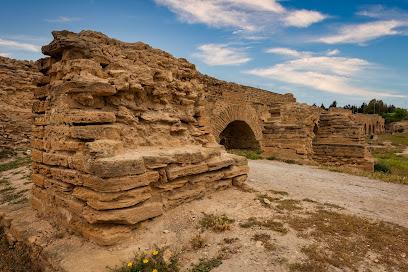
Lovers Spot
3.2 km
Experience breathtaking views and romantic ambiance at Lovers Spot in Carthage, a hidden gem for nature lovers and history enthusiasts alike.

Roman Columns
3.3 km
Explore the ancient Roman Columns in Carthage, a historical landmark that showcases the grandeur of Roman architecture and the rich heritage of Tunisia.

D'Art Des Métiers De Lella Salha
3.4 km
Discover the captivating blend of traditional and contemporary Tunisian art at D'Art Des Métiers De Lella Salha, a must-visit artisan gallery in Carthage.

Palais Dar Turki
3.4 km
Discover the elegance and historical charm of Palais Dar Turki, a guest house in Carthage that offers a unique blend of comfort and cultural richness.

Unmissable attractions to see
National Institute of Marine Sciences and Technologies Museum
0.2 km
Explore the depths of marine science at the National Institute of Marine Sciences and Technologies Museum in Salammbo, Tunisia.

Salammbo Tophet
0.5 km
Explore the ancient wonders of Salammbo Tophet, a historical landmark in Tunisia that reveals the fascinating Phoenician culture and heritage.

Carthage
0.5 km
Explore the ancient ruins and stunning coastal views of Carthage, a UNESCO World Heritage site that showcases Tunisia's rich historical tapestry.

Quartier Punique de Byrsa
0.8 km
Discover the ancient marvels at Quartier Punique de Byrsa, a UNESCO World Heritage Site in Carthage, Tunisia, rich in history and breathtaking views.

Quartier Magon
0.9 km
Explore Quartier Magon, an archaeological treasure in Carthage, Tunisia, revealing the splendor of ancient Phoenician civilization.

Carthage National Museum
0.9 km
Explore the rich history of Carthage at the National Museum, home to ancient artifacts that reveal the city's glorious past.

Stairs to the Beach and Sea
0.9 km
Discover the breathtaking Stairs to the Beach and Sea in Carthage, where history meets natural beauty for an unforgettable experience.

Archaeological site of Carthage
0.9 km
Explore the ruins of Carthage, a UNESCO World Heritage site, and immerse yourself in the rich history of this ancient Mediterranean civilization.

Saint Louis Cathedral in Carthage
1.0 km
Discover the architectural beauty and historical significance of the Saint Louis Cathedral in Carthage, a must-see for every traveler in Tunisia.
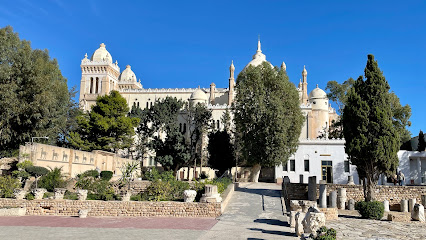
Les Ruines de Carthage
1.3 km
Unveil the ancient wonders of Carthage, a historical landmark full of captivating stories and breathtaking views of the Mediterranean.

Baths of Gargilius
1.3 km
Explore the ancient grandeur of the Baths of Gargilius in Carthage, a historical landmark showcasing Roman architectural brilliance and cultural heritage.

Baths of Antoninus
1.3 km
Experience the grandeur of ancient Rome at the Baths of Antoninus, an archaeological site where history meets breathtaking coastal views.
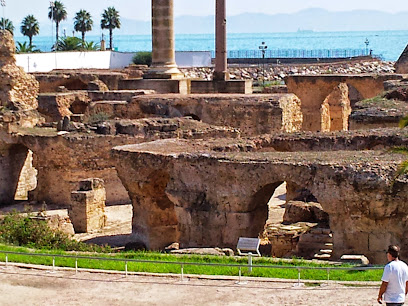
Site archéologique Carthage
1.4 km
Explore the archaeological marvels of Carthage, where ancient history meets breathtaking Mediterranean views, a must-visit for culture and history lovers.
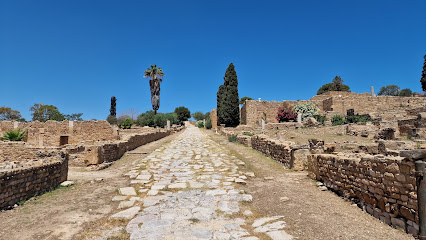
Roman Theatre of Carthage
1.5 km
Discover the Roman Theatre of Carthage, an ancient landmark showcasing the splendor of Roman architecture and the rich history of Tunisia.

Kobba Bent el Rey
1.5 km
Discover the rich history of ancient Carthage at Kobba Bent el Rey, an archaeological site showcasing stunning ruins and breathtaking Mediterranean views.

Essential places to dine
Restaurant Best Friend
0.4 km
Experience authentic Tunisian flavors at Restaurant Best Friend in Carthage - where culinary tradition meets modern dining in a historic setting.
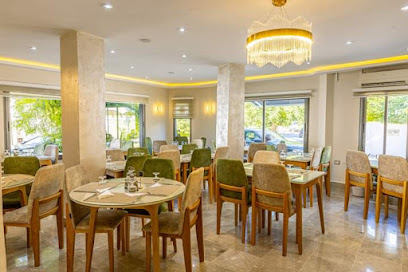
Les Indécis
0.5 km
Experience culinary excellence at Les Indécis in Tunis - where exquisite flavors meet warm hospitality.

Oiseau Bleu
1.9 km
Experience authentic Tunisian flavors at Oiseau Bleu in La Goulette - where every dish tells a story.

too much
2.0 km
Discover authentic Tunisian flavors at Too Much Restaurant in Tunis - where every meal tells a story of tradition and taste.

Peri Peri Restaurant in Tunisia
2.1 km
Discover authentic Tunisian cuisine at Peri Peri Restaurant – where every bite tells a story.

Amphitrite
2.3 km
Experience delightful Tunisian cuisine at Amphitrite in Carthage - where every meal tells a story.

CULT bistro
2.4 km
Experience the perfect blend of Tunisian tradition and modern culinary artistry at CULT Bistro in La Marsa.

El fel
2.6 km
Experience fine dining at El Fel in La Marsa - where Tunisian flavors meet modern elegance for an unforgettable meal.

Restaurant El Bey
3.0 km
Discover the flavors of Tunisia at Restaurant El Bey in Carthage – where family-friendly dining meets rich cultural heritage.

La Spigola
3.1 km
Discover the culinary delights of Tunisia at La Spigola - where fresh seafood meets local flavors in an inviting atmosphere.

Restaurant Djerbien The House - الحوش
3.1 km
Savor authentic Tunisian dishes at Restaurant Djerbien The House in La Goulette – where tradition meets flavor in every bite.

Raïs Labhar
3.2 km
Experience authentic Tunisian cuisine at Raïs Labhar with stunning views and fresh seafood near historical Carthage.

Leblebi chez Naceur (لبلابي)
3.3 km
Experience the rich flavors of Tunisia at Leblebi chez Naceur, renowned for its authentic lablabi and traditional dishes.

Oliveri sidi bou said
3.3 km
Experience exquisite Tunisian cuisine at Oliveri Sidi Bou Said, where every dish tells a story amidst stunning Mediterranean views.

IJA COOL
3.4 km
Experience authentic Tunisian cuisine at IJA COOL in Carthage - where tradition meets flavor in every dish.

Markets, malls and hidden boutiques
El Hanout
0.9 km
Explore El Hanout in Carthage for unique Tunisian gifts and handcrafted treasures that reflect the rich culture and artistry of the region.

Alyssa handcraft
1.0 km
Discover the charm of Tunisian craftsmanship at Alyssa Handcraft, a boutique offering exquisite handmade treasures in the heart of Carthage.

Anoushka pop up store
1.0 km
Explore Anoushka Pop-Up Store in Carthage for unique, handcrafted gifts and a taste of Tunisian culture.

Marsa Mall
3.1 km
Explore the vibrant Marsa Mall in La Marsa for a delightful shopping experience with diverse stores, dining options, and entertainment that promises fun for all ages.

Vente des produits de CHICHA
3.2 km
Discover the essence of Tunisian culture at Vente des produits de CHICHA, a vibrant shopping mall in historic Carthage, perfect for unique souvenirs.

Boutique Deyma
3.2 km
Explore Boutique Deyma in Carthage for unique handcrafted treasures that embody the artistic heritage of Tunisia.

Edokken
3.3 km
Explore Edokken, La Marsa's unique gift shop, offering authentic Tunisian crafts and souvenirs that celebrate the vibrant local culture.

Nathalie
3.3 km
Discover unique local craftsmanship at Nathalie Boutique in Carthage, where history and artistry come together for an unforgettable shopping experience.

Gallerie belle art
3.4 km
Explore the artistic treasures of Gallerie Belle Art in Carthage, where local craftsmanship meets cultural heritage in a stunning gift shop.

Watch Box Sidi Bou Said
3.4 km
Explore the charming Watch Box Sidi Bou Said, a gift shop filled with unique Tunisian treasures and local crafts that tell a story.

Le Hiboô Gift Store - Marsa
3.4 km
Explore Le Hiboô Gift Store in La Marsa for unique Tunisian souvenirs and artisan crafts reflecting the local culture and heritage.

EKCCI
3.4 km
Explore EKCCI Gift Shop in La Marsa for unique Tunisian souvenirs and artisan crafts, capturing the essence of Tunisia's rich culture.

Fakharmouna_ceramiques boutique N16
3.5 km
Explore the charm of handcrafted ceramics at Fakharmouna Ceramics Boutique in Carthage, where tradition meets artistry.

Belle art
3.5 km
Discover the essence of Tunisian craftsmanship at Belle Art, a charming gift shop in Sidi Bou Said, showcasing art and culture.

Boutique D'artisanat
3.5 km
Discover the charm of Tunisian craftsmanship at Boutique D'artisanat in Sidi Bou Said—your destination for unique, handcrafted souvenirs.
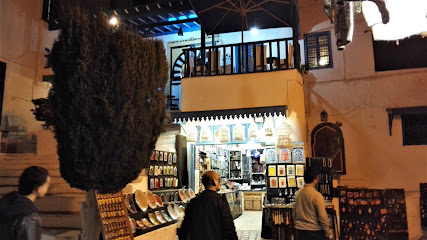
Essential bars & hidden hideouts
Restaurant Le Punique
0.5 km
Experience the authentic flavors of Tunisia at Restaurant Le Punique, where culinary tradition meets a stunning Carthaginian backdrop.

Hotel Villa Didon
0.8 km
Discover unparalleled luxury at Hotel Villa Didon, where history meets modern elegance with stunning views over Carthage and the Mediterranean.

Le Perchoir
0.8 km
Discover the stunning views and vibrant atmosphere of Le Perchoir, the ultimate lounge experience in the historic city of Carthage.

The Phoenix Club - Karthago
1.5 km
Discover authentic Tunisian flavors at The Phoenix Club in Karthago, where culinary tradition meets vibrant dining.

The Wave Bar
1.6 km
Experience the vibrant ambiance of The Wave Bar, a chic lounge by the sea in Le Kram, Tunisia, perfect for relaxation and socializing.

The Alibi
2.8 km
Experience the vibrant nightlife of La Goulette at The Alibi, where locals and tourists enjoy a lively atmosphere and delicious drinks.

Wet Flamingo
2.9 km
Discover the vibrant nightlife of La Goulette at Wet Flamingo, a lively bar offering a variety of drinks in a friendly atmosphere.

Breath - Salad Bar
3.0 km
Discover fresh and healthy dining at Breath - Salad Bar, nestled in the historic beauty of Carthage, Tunisia.

Le Central - Sports Bar
3.2 km
Experience the thrill of sports in Gammarth at Le Central, the ultimate sports bar for fans and food lovers alike.

Le Carpe Diem - Tunis
3.2 km
Discover the lively atmosphere and exquisite tapas at Le Carpe Diem, La Marsa's premier destination for cocktails and live music.

La Tournelle
3.5 km
Experience the rich flavors of Tunisian cuisine at La Tournelle, a charming restaurant in Sidi Bou Said with breathtaking Mediterranean views.

BAMBALOUNI
3.5 km
Experience the authentic taste of Tunisia at Bambalouni, nestled near the historic ruins of Carthage, where every dish tells a story.

O Club La Goulette
3.6 km
Experience the vibrant nightlife of La Goulette at O Club La Goulette, where great drinks and a lively atmosphere await every visitor.

YAS Shisha lounge
3.6 km
Discover the authentic flavors of Tunisia at YAS Shisha Lounge in La Marsa, where shisha and tea combine for a cultural experience.

Café des Délices (Café Sidi Chabaane)
3.6 km
Discover the enchanting Café des Délices in Sidi Bou Said, a serene spot offering stunning Mediterranean views and delicious Tunisian treats.




